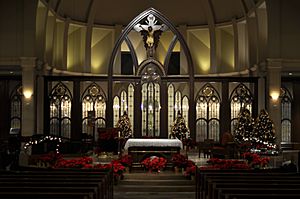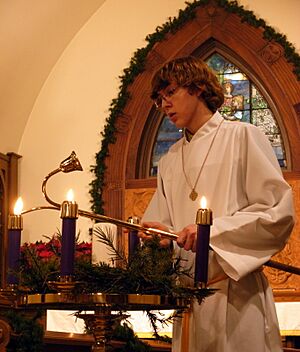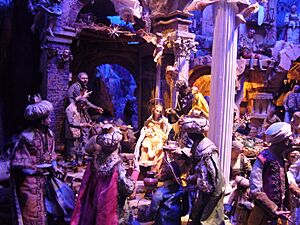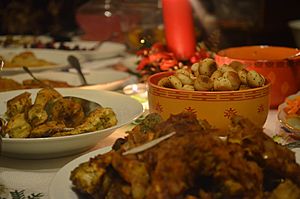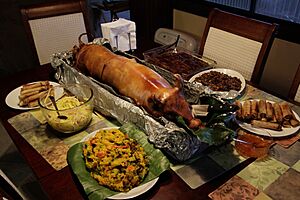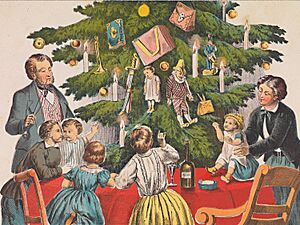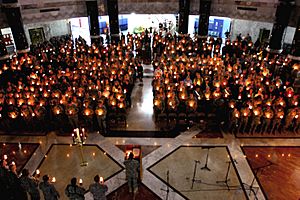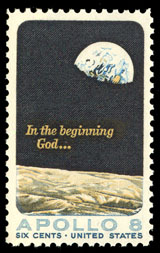Christmas Eve facts for kids
Quick facts for kids Christmas Eve |
|
|---|---|
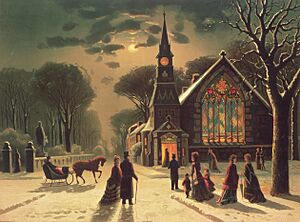
Christmas Eve, an 1878 painting by J. Hoover & Son
|
|
| Also called | Vigil of the Nativity Christmas Evening Christmas Vigil Day before Christmas Night before Christmas |
| Observed by | Christians Many non-Christians |
| Type | Christian, cultural |
| Significance | Day or evening preceding the traditional birthday of Jesus |
| Observances | Gift shopping, gift giving, goodwill greetings, Midnight Mass, other church services, meals, preparations for the arrival of Christmas gift-bringers, preparing for Christmas |
| Date |
|
| Frequency | Annual |
| Related to | Christmas, Christmastide, New Year's Eve, New Year's Day |
Christmas Eve is the evening or the whole day right before Christmas. Christmas is a special holiday that celebrates the birth of Jesus. People all over the world celebrate Christmas Day. Christmas Eve is also a widely observed holiday, either fully or partially, as people get ready for Christmas Day. Both days together are super important celebrations in Christendom (Christian countries) and Western society.
Christmas celebrations in Christian churches in the West have always started on Christmas Eve. This is partly because the Christian day traditionally begins at sunset, just like in Jewish tradition. This idea comes from the story of Creation in the Book of Genesis, which says: "And there was evening, and there was morning—the first day." Many churches still ring their church bells and hold prayers in the evening. For example, the Lutheran churches in Nordic countries do this.
Since it's believed that Jesus was born at night (from Luke 2:6-8), a special service called Midnight Mass is held on Christmas Eve, usually at midnight. This service remembers his birth. The idea of Jesus being born at night is why Christmas Eve is called Heilige Nacht (Holy Night) in German, and Nochebuena (the Good Night) in Spanish. It's also why we sing songs like "Silent Night, Holy Night".
Many other traditions happen on Christmas Eve around the world. Families and friends gather, sing Christmas carols, enjoy Christmas lights and decorations, and exchange gifts. Famous gift-givers like Santa Claus, Father Christmas, Christkind, and Saint Nicholas are often said to start their journey to deliver presents on Christmas Eve. However, before the Protestant Christkind tradition in the 1500s, these figures usually delivered gifts on the eve of Saint Nicholas' feast day (December 6).
Contents
Religious Traditions
Western Churches
In Western churches, Christmas Eve is traditionally seen as a special religious observance, different from the services on Christmas Day. It's like the last day of Advent, which is the time of waiting before Christmas. So, the traditional color used in churches for Christmas Eve is violet.
Over time, Christmas Day celebrations have started earlier and earlier, extending into Christmas Eve. While Roman Catholics, Lutherans, and some Anglicans traditionally have Midnight Mass (the first service of Christmas) at or near midnight, some churches now hold it earlier, like 7 pm. This makes it easier for families with young children to attend.
Midnight Mass is celebrated in churches worldwide to honor the birth of Christ, which is believed to have happened at night. It's very popular in Poland (called pasterka) and Lithuania (piemenėlių mišios). In Latin America and Spain, it's known as "Rooster's Mass" (Misa de Gallo). In the Philippines, this tradition has grown into a nine-day event called Simbang Gabi, where people attend early morning services from December 16 until Christmas Eve.
Many families set up a nativity scene indoors or outdoors. This scene has figures of baby Jesus in a manger, Mary, and Joseph. It might also include angels, shepherds, and animals. The Magi (wise men) are sometimes added later, after Christmas, to show their journey to Bethlehem. While most home nativity scenes are put away after Christmas, church nativity scenes often stay up until the feast of the Baptism of the Lord.
The Church of Scotland has a service just before midnight on Christmas Eve, where carols are sung. These Christmas Eve services are very popular.
On Christmas Eve, the Christ Candle in the middle of the Advent wreath is often lit during church services. In candlelight services, while singing Silent Night, everyone gets a candle and shares the flame, which starts from the Christ Candle.
Lutherans celebrate Christmas Eve with traditions from Germany and Scandinavia. They have "Krippenspiele" (Nativity plays), special music, and candlelight services. Christmas Vespers (evening prayers) are popular, and Midnight Masses are common. Some regions still have an old Lutheran tradition of a Christmas Vigil early on Christmas Day. In parts of Germany, groups in different parts of the church sing verses of the song "He whom shepherds once came Praising" back and forth.
Methodists celebrate Christmas Eve in different ways. Some have Holy Communion services with their families in the early evening. These are very quiet, with only the Advent Wreath and candles on the Lord's Table for light. Others have services of light, where they sing Silent Night as many candles are lit. Some churches have late evening services, around 11 pm, so they can celebrate Christmas Day together when the bells ring at midnight.
The annual "Nine Lessons and Carols" broadcast from King's College, Cambridge on Christmas Eve is a popular Christmas tradition in the United Kingdom. It's also broadcast around the world.
Eastern Churches
In the Byzantine Rite (used by Eastern Orthodox churches), Christmas Eve is called Paramony, meaning "preparation." It's the last day of the Nativity Fast, and many devout Christians fast strictly on this day. Some traditions say nothing is eaten until the first star appears in the evening sky, remembering the Star of Bethlehem. The church celebration starts earlier in the day with special services, including readings from the Old Testament that tell the story of salvation. After the service, a new candle is lit in the center of the church, and everyone gathers to sing hymns.
In the evening, a long service called the All-Night Vigil is held. The services on Christmas Eve are similar to those on Good Friday, showing that the birth of Jesus was meant to lead to his Crucifixion and Resurrection. This is shown in Eastern icons of the Nativity, where baby Jesus is wrapped in swaddling clothes that look like his burial cloths. He is also shown lying on a stone, which represents the Tomb of Christ, instead of a manger. The Cave of the Nativity also reminds us of the cave where Jesus was buried.
In some Orthodox cultures, after the evening service, families go home for a festive meal. However, they still follow Orthodox fasting rules, meaning no meat or dairy products. Then, they return to church for the All-Night Vigil.
The next morning, Christmas Day, another special service is held. After this service, people greet each other with a kiss of peace and say: "Christ is Born!" The other person replies: "Glorify Him!" This greeting and many hymns are used until December 31.
The first three days of Christmas are very important. The second day honors the Virgin Mary, and the third day is simply "the Third Day of the Nativity." Eastern Christians celebrate for twelve days, during which no one in the Church fasts, even on Wednesdays and Fridays, which are usually fasting days.
Christmas Eve Dinner
Many countries have special meals on Christmas Eve.
Bulgaria
In Bulgaria, the meal has an odd number of dishes that follow fasting rules (no meat). These usually include traditional sarma (cabbage rolls), bob chorba (bean soup), a special pastry called kravai with a fortune inside, stuffed peppers, nuts, dried fruit, and boiled wheat. People often drink wine or rakia, a traditional Bulgarian drink.
Cuba
In Cuba, roasted pig (lechón) is often the main dish for Christmas Eve (Nochebuena). This tradition might go back to the 1400s when colonists roasted pigs. Cuban families, including those in Florida and the United States, continue this tradition. The pig is sometimes cooked in a Caja China, a large box where a whole pig is roasted under hot coals. The dinner includes many side dishes and desserts, and people often play dominoes.
On December 24th, the Christmas Eve dinner is the main celebration. Many people wear new clothes. Cuban families don't have a fixed dinner time, but it's important to eat together. The meal often includes black beans, white rice, yuca con mojo (a root vegetable with garlic sauce), roasted pork, and homemade desserts like Christmas fritters and sweets. In 1998, Pope John Paul II visited Cuba, and the Cuban government declared December 25th a holiday again, after many years.
Czech Republic
In the Czech Republic, fasting on Christmas Eve (or only eating meatless food) is an old tradition. People believe that if you fast until Christmas dinner, you will see a golden pig, which is a symbol of good luck. A typical Christmas breakfast is a sweet braided bread called vánočka. Christmas Eve dinner usually has baked or fried carp and potato salad.
France
In French-speaking areas, Réveillon is a long, festive dinner eaten on Christmas Eve.
Italy
Christmas in Italy starts on December 8th with the Feast of the Immaculate Conception, when Christmas trees are traditionally put up. It ends on January 6th with the Epiphany. Traditionally, the Christmas Eve dinner should not have meat. Many people go to Midnight Mass on Christmas Eve and follow the old custom of not eating meat that day. Gift-giving traditions vary; gifts might be exchanged on Christmas Eve or Christmas Day.
While other Christian families eat various meats, Italians (especially Sicilians) celebrate the traditional Catholic "Feast of the Seven Fishes". This meal was historically eaten after a 24-hour fasting period. Even though fasting is less common now, some Italian-Americans still enjoy a meatless Christmas Eve feast and attend Midnight Mass. In many cultures, a festive dinner is served when the first star appears in the sky.
Lithuania
Lithuanian Christmas Eve, called Kūčios ("Holy Meal"), mixes old pagan and Christian traditions. It was originally a celebration of the winter solstice. Lithuanians used to believe that animals could talk on this night and that you could predict the future. Kūčios is the most important family gathering of the year. Empty plates are set at the table to remember relatives who have passed away. The feast begins after the evening star rises. No meat, milk, or alcohol is allowed. Twelve dishes are served, all made from grains, fish, dried fruit, or mushrooms, including kūčiukai (small biscuits soaked in poppy seed milk). After dinner, the table is left uncleared overnight for the spirits.
Philippines
In the Philippines, the traditional dinner (called noche buena) is served at midnight after families attend the late evening Mass known as Misa de Gallo. Common dishes include: lechón (roasted pig), different types of pancit (noodles), Filipino spaghetti, hamonado (sweet cured pork), jamón (Christmas ham), queso de bola (Edam cheese), and many other meat and vegetable dishes. Almost all these dishes are eaten with white rice. Desserts include úbe halayá (purple yam dessert), leche flan, macaroni salad, fruit salad, and various kakanin (rice cakes). Popular drinks are tsokolate (hot chocolate), coffee, soda, wine, beer, and fruit juices.
Poland

Poland has a tradition similar to Italy, called Wigilia (Christmas Vigil). Traditionally, 12 dishes are served, but in the past, it was an odd number. The number of dishes used to depend on social class. It's important to try a bit of all the dishes. Some traditions say the number of guests cannot be odd.
In Poland, gifts are opened on Christmas Eve, not Christmas Day. This comes from combining the traditions of Saint Nicholas Day (December 6) and Christmas.
Puerto Rico
In Puerto Rico, the traditional Christmas Eve dinner includes arroz con gandules (rice with pigeon peas), lechón asado (roasted pig) or pernil asado (roasted pork shoulder), morcilla (blood sausage), pasteles (meat-filled dough), and various salads. Traditional desserts are arroz con dulce (coconut rice pudding), tembleque (coconut pudding), and different types of flan and cookies. Popular drinks are coquito (coconut eggnog), rum, and Pitorro (moonshine rum).
Ukraine
In Ukraine, Sviatyi Vechir (Holy Evening) is celebrated with a meatless twelve-dish Christmas Eve supper, also called the Holy Supper. The main dishes are kutia (a poppy seed, honey, and wheat dish) and uzvar (a drink from dried fruits). Other typical dishes include borscht, varenyky (dumplings), and dishes made of fish, beans, and cabbage.
The twelve dishes represent the Twelve Apostles. Just like in Poland, it's important to try a bit of all the dishes. The table is covered with a white cloth, symbolizing the swaddling clothes baby Jesus was wrapped in. A large white candle in the center represents Christ the Light of the World. Next to it is a round loaf of bread, symbolizing Christ as the Bread of Life. Hay is often placed on the table or as a decoration, reminding everyone of the manger in Bethlehem.
Venezuela
In Venezuela, hallacas (a type of tamale) are usually the main dish for Noche Buena, along with ham or pork leg called "pernil," panettone, rum, and "Ponche Crema" (a type of eggnog). The night usually features traditional Christmas music called "aguinaldos."
Gift Giving
During the Reformation in the 1500s and 1600s, many Protestants changed the gift-giver to the Christ Child (Christkindl). The date for giving gifts also changed from December 6th to Christmas Eve. This is the night when Santa Claus is said to deliver gifts to good children. Many people believe the custom of giving gifts comes from the Magi (wise men) who brought gifts to the Christ child in the manger.
In Austria, Croatia, the Czech Republic, Hungary, and Slovakia, where Saint Nicholas gives gifts on December 6th, the Christmas gift-giver is the Child Jesus.
In many European countries like Austria, Germany, and Sweden, presents are traditionally exchanged on the evening of December 24th. Children are often told that gifts were brought by the Christkind (German for Christ child) or by the Weihnachtsmann. Both leave the gifts without being seen. In Germany, gifts are also brought on December 6th by "the Nikolaus" with his helper Knecht Ruprecht.
In Estonia, Finland, Denmark, Norway, and Sweden, a figure like Santa Claus personally meets children and gives presents on Christmas Eve.
In many countries, including Argentina, France, Germany, and Poland, Christmas presents are opened mostly on the evening of the 24th. This is also the practice for the British Royal Family, a tradition started by Queen Victoria and Albert, Prince Consort. In other countries like the United States, the United Kingdom, and Australia, gifts are usually opened on Christmas Day morning.
In other Latin American countries, people stay awake until midnight to open their presents.
In Spain, gifts are traditionally opened on the morning of January 6th, Epiphany day. However, in some countries like Mexico, people receive presents around Christmas and on Epiphany day.
In Belgium and the Netherlands, Saint Nicholas or Sinterklaas and his helper Zwarte Piet deliver presents on the evening of December 5th. On December 24th, people usually go to church or watch Mass on TV, or have a meal.
Other Traditions
Christmas Eve is celebrated differently around the world. Common traditions include attending special religious services like Midnight Mass and exchanging presents. Christmas is one of the most important times in the Christian calendar. It's often connected to other holidays around this time, like Advent, St. Nicholas Day, and New Year's.
Many people travel for vacation or to visit family during the Christmas season. This means Christmas Eve is also a time for social events and parties worldwide.
In Jewish Culture
Nittel Nacht is a name given to Christmas Eve by Jewish scholars in the 1600s.
In Contemporary American-Jewish Culture
Since Christmas Day is a work holiday in the United States, many businesses and parts of society are closed. This can sometimes make American Jews feel a bit lonely or left out, as they don't celebrate Christmas in the same way.
Jewish people usually don't have the same family gatherings and religious worship activities that are central to Christmas Eve for Christians.
Common activities for American Jews on Christmas Eve have often been "Chinese and a movie." This means eating a meal at a Chinese restaurant, which tend to be open on Christmas, and watching a movie at the theater or at home.
Since the 1980s, many social events for young Jewish people have become popular on Christmas Eve. These include events like the Matzo Ball and The Ball, as well as local events organized by Jewish communities in North America.
In Chinese Culture
In Mandarin Chinese, Christmas Eve is called Píng'ān yè (平安夜), which means "peaceful night." This name comes from the Chinese title of the Christmas carol Silent Night. People often exchange apples because the word for "apple" (苹果) sounds similar to the word for "peace" (平安).
In Inuit Culture
In Inuit territories, Christmas Eve is called Quviasukvik. The Inuit celebrate it as their new year.
United States
In New Mexico and parts of San Diego, California, Christmas Eve (nochebuena) is celebrated by lighting luminarias and farolitos. These are small paper lanterns or fires that light up paths and homes.
Historical Events
Christmas Truce
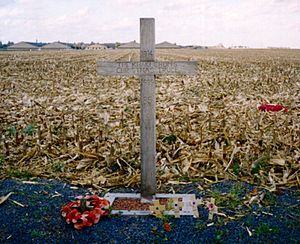
Some historical events have happened on Christmas Eve. One famous event is the Christmas truce during World War I in 1914 and 1915. This was an unofficial ceasefire, especially between British and German soldiers. It started on Christmas Eve, December 24, 1914. German troops began decorating their trenches near Ypres, Belgium, with candles and sang Christmas carols like Stille Nacht. The British troops across from them responded by singing English carols. Both sides shouted Christmas greetings. Soon, soldiers from both sides met in "No man's land" (the area between the trenches) and exchanged small gifts. This truce happened even though military leaders didn't want it. Earlier, Pope Benedict XV had asked for an official truce, but it was ignored.
On December 24, 1968, the Apollo 8 astronauts Bill Anders, Jim Lovell, and Frank Borman surprised the world. In what was the most-watched TV broadcast at the time, they read from the Creation story in the Book of Genesis as they orbited the Moon.
In 1969, the United States Postal Service released a stamp to remember the Apollo 8 flight. The stamp showed a part of Anders' famous Earthrise photograph, taken on Christmas Eve, with the words, "In the beginning God...".
See also
 In Spanish: Nochebuena para niños
In Spanish: Nochebuena para niños


